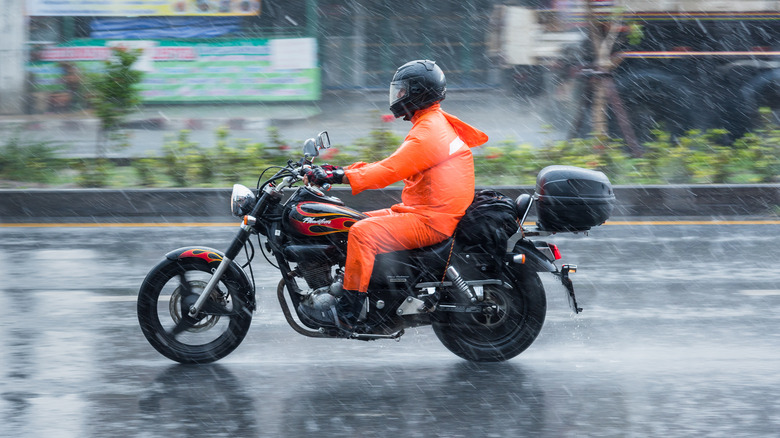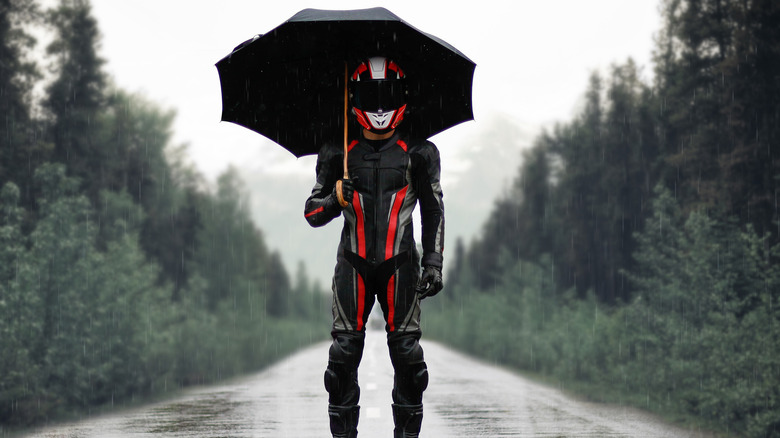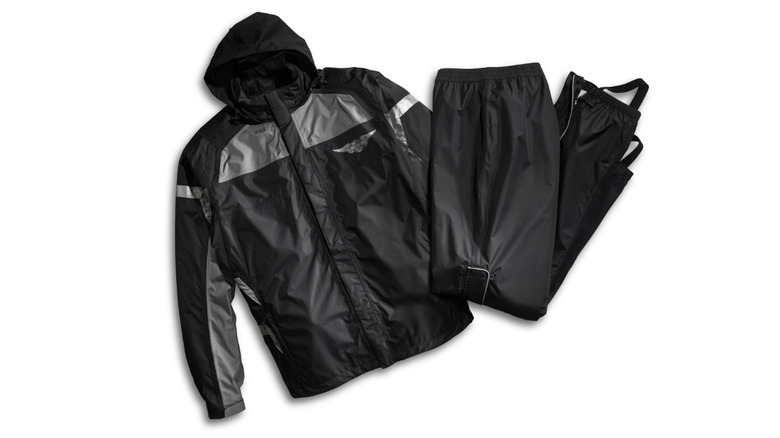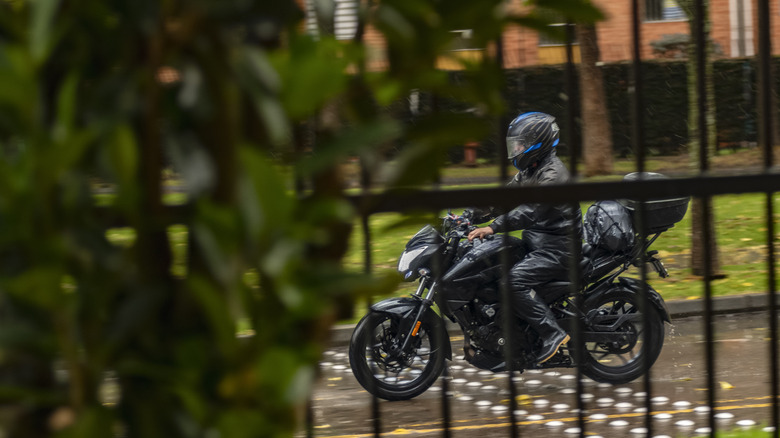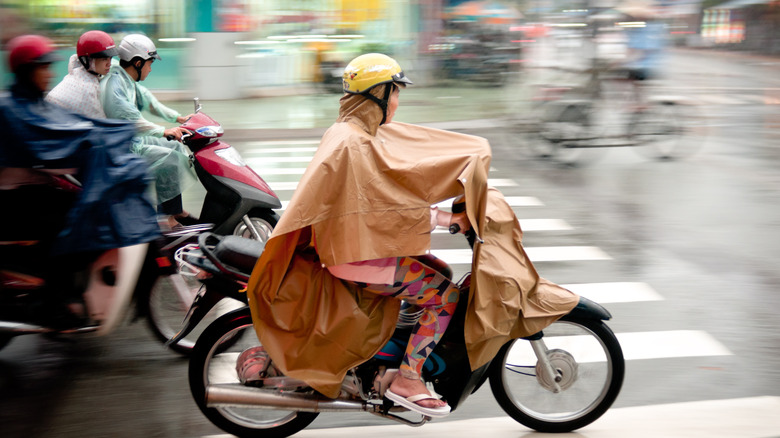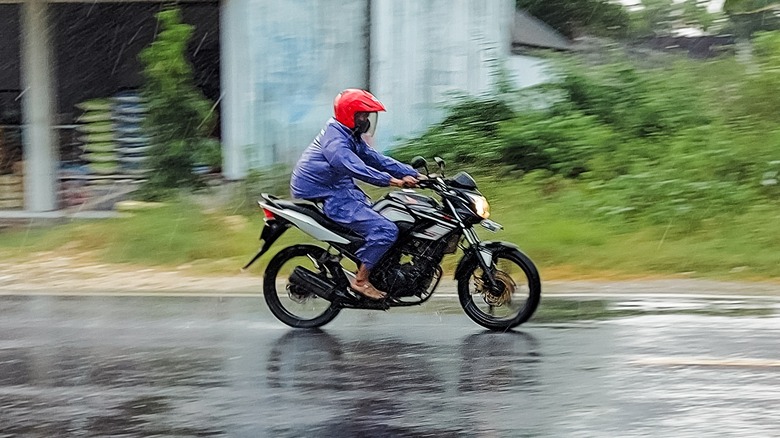5 Things To Keep In Mind When Choosing Motorcycle Rain Gear
If you're like countless motorcyclists out there, there's little that will keep you off your ride. Even the rain is no deterrent for many. As we move through the warm months of the year, encountering rainfall is inevitable, more so if you already live in an area with heavy downpours. While the best motorcycles today are equipped to handle these conditions, so long as you're riding carefully, keeping yourself protected during a sudden storm is a different story. The best way to keep yourself dry and well-insulated in such a scenario is by donning motorcycle rain gear.
Picking the right rain gear is nearly as important as finding a safe motorcycle. More than just a way of keeping from getting drenched, it is a good safety measure for both yourself and those you share the road with. But there are plenty of important factors to consider before going through and getting one for yourself. Like other common motorcycle accessories, rain gear comes in a wide array of styles, materials, body sizes, and toughness. As tempting as it might be to go with the most popular or expensive brand out there, it's important to first consider your needs and find motorcycle gear that best reflects those considerations. To help you get off on the right foot, we've compiled a list of a few of the most important things to consider when choosing your motorcycle rain gear.
Easiness to put on
Of course, the first step of putting on your motorcycle rain gear is, well, putting it on. This may seem like a no-brainer so long its size matches your body type, but there are some important factors to consider when it comes to finding rain gear that you can put on and take off with ease.
There are two kinds of motorcycle rain suits you'll have to choose from — a one or two piece. One piece rain suits generally offer the most thorough protection overall, as they cover your entire body, whereas a two piece suit, unless fitted with a zippered waist, will leave your mid-section vulnerable to the elements. The caveat to this is that a one piece is far more difficult to get out of and conveniently store away. A two piece is much more easy to do this with, with the added conveinence of being able to only don one half of outfit for less extreme weather.
Your decision will ultimately depend on how intense the rain gets in your location. A one piece is good for those who live in areas with more consistently extreme downpour, while a two piece is good if you only experience a bad storm every now and then. It may even not be a bad idea to have both options at your disposal to be prepared for any occasion.
Breathability
How much layering your rain suit has will obviously depend on the climate of wherever you live. But regardless of what kind of protection you need, it's important to make sure that whatever rain suit you choose maintains some level of breathability.
It can be easy to overheat while wearing your rain gear with an extreme amount of layers, even on cold days when you're typically donning more heat-inducing layers than usual. As a result, it can be tricky to find a rain suit that strikes a good balance of something that's breathable while protecting you from the elements. You'll largely want to stay away from Z-liners in this regard, as the exterior of the suit can easily get weighed down by excessive rain water, thus providing less sufficient airflow.
The best kind of rain suit to shoot for is one with a laminated waterproof exterior. As opposed to the more restrictive Z-liner, having the waterproof layer remain strictly around the suit rather than be a separate interior layer allows for better ventilation. Additionally, there are removable waterproof liners that can be worn either over or under your rain suit, giving a versatile option to those who live in areas with fluctuating temperatures. Keep in mind that it will take some time to put these on and off, so you may still get wet depending on where you are when you apply them.
Seams
Obviously, the biggest reason why you'd want motorcycle rain gear is to stay protected from the rain. While the suit as a whole needs to be sturdy enough to handle various weather conditions, the devil really is in the details when it comes to finding something that will last. That's why it's important to look into the seams of the rain gear you pick out.
Without proper seaming, even the best material won't keep you completely dry for long. Ensure your rain suit has seams that are sewn in or bonded together using heat. Pay close attention to the armpit, crotch, and chest areas as these are especially prone to leaks. Additionally, you can readily find seam-sealing adhesive tape to add extra protection or fix up the weaker areas on your suit.
Likewise, be sure that the zippers are also tight and secure. You might be surprised to know that many rain suit zippers are only water-resistant and not fully waterproof. In general, the thicker and sturdier the zipper is, the better durable it will be to the elements.
Materiality
While we've touched upon some aspects to keep in mind when it comes to motorcycle rain gear material in prior sections, it's worth diving a little deeper into this subject. The kind of material your rain suit is made out of not only determines its endurance to the elements, but is also key to knowing how much it will cost.
The most common and cost-effective rain suits are typically made using nylon or polyester. The downside is that the breathability of this type of rain gear will be more affected by the amount of layers added on. Similarly, rain gear made using PVC can also restrict air flow.
Other materials such as waxed cotton and breathable leather have been engineered to deliver enhanced protection while allowing for better ventilation. However, they often come in at a higher price, so make sure it's something you really need before investing in it. Take the time to look into and research the materiality of whatever brand you choose, and see if other customers have experienced any issues in the past.
Safety and visibility
It's certainly not impossible to ride your motorcycle in the rain, but it is something that should be approached with caution. Even in lighter rain, you're more susceptible to slipping or getting into accidents, while more heavy downpours can more seriously affect your visibility. Along with putting care into how you ride, picking out the proper rain gear will help limit the potential danger that comes with riding in the rain.
Nowadays, you can find plenty of rain suits and gear fitted with helpful safety features. For those who continuously experience reduced visibility from their breath fogging up their helmet visor, it's a good idea to find rain gear with a breath guard and pin lock system, as these items aid in cutting down on condensation. Having extra padding in the suit itself can also be helpful in lessening the impact of a potential collision. In particular, you'll want to make sure your knees, elbows, and shoulders have some kind of extra protection.
Along with keeping yourself safe, you'll also want to be considerate of others on the road, who may have a harder time spotting you on the road in such conditions. Shoot for rain suits that sport bright colors such as yellow or orange, as these are easy to identify in tough weather. You'll also find that many rain suits come equipped with reflective strips or logos that help you remain visible.
